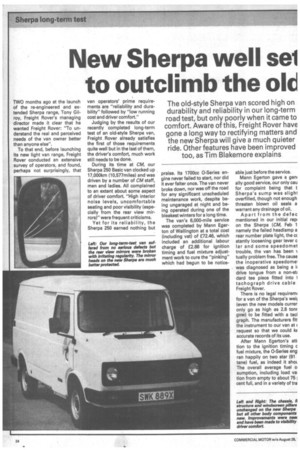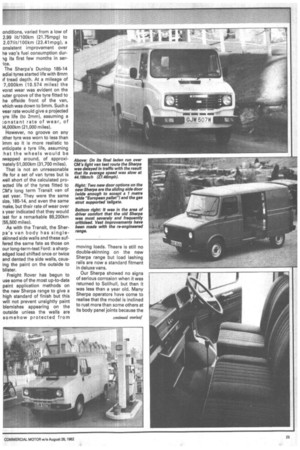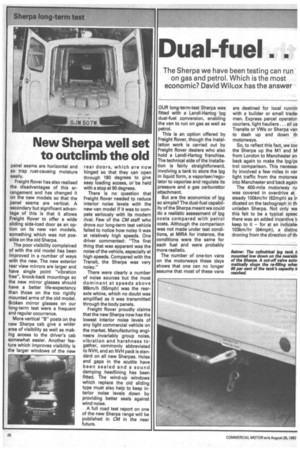New Sherpa well sei to outclimb the old
Page 18

Page 19

Page 20

If you've noticed an error in this article please click here to report it so we can fix it.
The old-style Sherpa van scored high on durability and reliability in our long-term road test, but only poorly when it came to comfort. Aware of this, Freight Rover have gone a long way to rectifying matters and the new Sherpa will give a much quieter ride. Other features have been improved too, as Tim Blakemore explains
TWO months ago at the launch of the re-engineered and extended Sherpa range, Tony Gilroy, Freight Rover's managing director made it clear that he wanted Freight Rover: "To understand the real and perceived needs of the van owner better than anyone else".
To that end, before launching its new light van range, Freight Rover conducted an extensive survey of operators, and found, perhaps not surprisingly, that van operators' prime requirements are "reliability and durability" followed by "low running cost and driver comfort."
Judging by the results of our recently completed long-term test of an old-style Sherpa van, Freight Rover already satisfies the first of those requirements quite well but in the last of them, the driver's comfort, much work still needs to be done.
During its time at CM, our Sherpa 250 Basic van clocked up 17,000km (10,577m11es) and was driven by a number of CM staff, men and ladies. All complained to an extent about some aspect of driver comfort. "High interior noise levels, uncomfortable seating and poor visibility (especially from the rear view mirrors)" were frequent criticisms.
Yet for its reliability, the Sherpa 250 earned nothing but praise. Its 1700cc 0-Series engine never failed to start, nor did it ever falter once. The van never broke down, nor was off the road for any significant unscheduled maintenance work, despite being ungaraged at night and being operated during one of the bleakest winters for a long time.
The van's 6,000-mile service was completed by Mann Egerton of Wallington at a total cost (including vat) of £72.46, which included an additional labour charge of £2.88 for ignition timing and fuel mixture adjustment work to cure the "pinking" which had begun to be notice
able just before the service.
Mann Egerton gave a geni ally good service, our only cau for complaint being that t Sherpa's sump was sligh1 overfilled, though not enough threaten blown oil seals a warrant any drainage of oil.
Apart from the defec mentioned in our initial rep on the Sherpa (CM, Feb 1 namely the failed headlamp a rear number plate light, the cc stantly loosening gear lever c lar and some speedomet trouble, the van has been tually problem free. The cause the inoperative speedomei was diagnosed as being a h drive tongue from a non-st dard tee piece fitted into 1 tachograph drive cable Freight Rover.
There is no legal requiremi for a van of the Sherpa's weil (even the new models curren only go as high as 2.8 tonr gvw) to be fitted with a tadl graph. The manufacturers fit1 the instrument to our van at request so that we could kE accurate records of its use.
After Mann Egerton's atti tion to the ignition timing c fuel mixture, the 0-Series eng ran happily on two star (91 tane) fuel, as indeed it shoi The overall average fuel cl sumption, including load vai tion from empty to about 75 I cent full, and in a variety of tra onditions, varied from a low of 2.99 lit/100km (21.75mpg) to 2.0711t/100km (23.41mpg), a onsistent improvement over he van's fuel consumption durIg its first few months in serrice.
The Sherpa's Dunlop 185-14 adial tyres started life with 8mm rf tread depth. At a mileage of 7,000km (10.574 miles) the vorst wear was evident on the ,uter groove of the tyre fitted to he offside front of the van, vhich was down to 5mm. Such a year rate would give a projected yre life (to 2mm), assuming a ;onstant rate of wear, of 14,000km (21,000 miles).
However, no groove on any )ther tyre was worn to less than imm so it is more realistic to inticipate a tyre life, assuming hat the wheels would be ;wapped around, of approxiriately 51,000km (31,700 miles). That is not an unreasonable ife for a set of van tyres but is well short of the calculated proected life of the tyres fitted to r:M's long term Transit van of ast year. They were the same size, 185-14, and even the same make, but their rate of wear over 3 year indicated that they would ast for a remarkable 89,200km (55,500 miles).
As with the Transit, the Sherpa's van body has singleskinned side walls and these suffered the same fate as those on our long-term-test Ford: a sharpedged load shifted once or twice and dented the side walls, causing the paint on the outside to blister.
Freight Rover has begun to use some of the most up-to-date paint application methods on the new Sherpa range to give a high standard of finish but this will not prevent unsightly paint blemishes appearing on the outside unless the walls are somehow protected from moving loads. Theere is still no double-skinning on the new Sherpa range but load lashing rails are now a standard fitment in deluxe vans.
Our Sherpa showed no signs of serious corrosion when it was returned to Solihull, but then it was less than a year old. Many Sherpa operators have come to realise that the model is inclined to rust more than some others at its body panel joints because the panel seams are horizontal and so trap rust-causing moisture easily.
Freight Rover has also realised the disadvantages of this arrangement and has changed it on the new models so that the panel seams are vertical. A secondary but significant advantage of this is that it allows Freight Rover to offer a wide sliding side-load door as an option on its new van models, something which was not possible on the old Sherpa.
The poor visibility complained of with the old model has been improved in a number of ways with the new. The new exterior rear view mirrors are larger and have single point "vibration free", knock-back mountings so the new mirror glasses should have a better life-expectancy than those on the too rigidly mounted arms of the old model. Broken mirror glasses on our long-term test were a frequent and regular occurrence.
More vertical "B" posts on the new Sherpa cab give a wider area of visibility as well as making access to the driver's cab somewhat easier. Another feature which improves visibility is the larger windows of the new rear doors, which are now hinged so that they can open through 180 degrees to give easy loading access, or be held with a stop at 90 degrees.
There is no question that Freight Rover needed to reduce interior noise levels with the new van model if it was to compete seriously with its modern rival. Few of the CM staff who drove our long-term test vehicle failed to notice how noisy it was at relatively high speeds. One driver commented: "The first thing that was apparent was the noise of the vehicle, especially at high speeds. Compared with the Transit, the Sherpa was very noisy."
There were clearly a number of noise sources but the most dominant at speeds above 88km/h (55mph) was the rearaxle whine, which no doubt was amplified as it was transmitted through the body panels.
Freight Rover proudly claims that the new Sherpa now has the lowest interior noise levels of any light commercial vehicle on the market. Manufacturing engineers invariably group noise, vibration and harshness together, commonly abbreviated to NVH, and an NVH pack is standard on all new Sherpas. Holes and gaps in the scuttle have been sealed and a sound damping headlining has been fitted. The wind-up windows which replace the old sliding type must also help to keep interior noise levels down by providing better seals against wind noise.
A full road test report on one of the new Sherpa range will be published in CM in the near future.








































